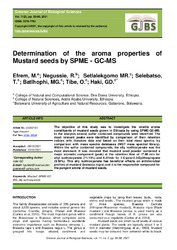| dc.contributor.author | Efrem, M. | |
| dc.contributor.author | Negussie, R. | |
| dc.contributor.author | Setlalekgomo, MR. | |
| dc.contributor.author | Selebatso, T. | |
| dc.contributor.author | Batlhophi, MG. | |
| dc.contributor.author | Tibe, O. | |
| dc.contributor.author | Haki, GD. | |
| dc.date.accessioned | 2022-08-24T09:39:09Z | |
| dc.date.available | 2022-08-24T09:39:09Z | |
| dc.date.issued | 2021-10-10 | |
| dc.identifier.issn | 2276-7762 | |
| dc.identifier.uri | https://hdl.handle.net/13049/530 | |
| dc.description.abstract | The objective of this study was to investigate the volatile aroma
constituents of mustard seeds grown in Ethiopia by using SPME-GC-MS.
In the analysis several sulfur contained compounds were identified. The
most relevant peaks were identified by comparison of their retention
indices with literature data and based on their total mass spectra, by
comparison with mass spectra databases (NIST mass spectral library).
Within the sulfur contained compounds, the ally isothiocyanate was the
most dominant. It was revealed that mustard seed powder contained a
major aromatic component (peak) at the retention time of 17.69 min for
allyl isothiocyanate (71.13%) and 9.57min for 1-Cyano-2,3-Epithiopropane
(9.54%). This ally isothiocyanate has beneficial effects on antimicrobial
profiles of mustard (brassica nigra) and it is the responsible compound for
the pungent aroma of mustard seeds. | en_US |
| dc.language.iso | en | en_US |
| dc.publisher | Greener Journal of Biological Sciences | en_US |
| dc.relation.ispartofseries | Greener Journal of Biological Sciences;Vol. 11(2), pp. 93-98, 2021 | |
| dc.subject | Mustard | en_US |
| dc.subject | SPME-GC- MS | en_US |
| dc.subject | ally isothiocyanate | en_US |
| dc.title | Determination of the aroma properties of Mustard seeds by SPME - GC-MS | en_US |
| dc.type | Article | en_US |

